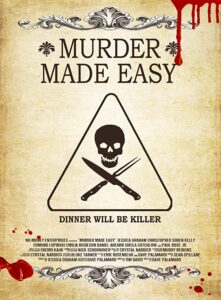David Palamaro’s micro-budgeted murder mystery is a delightful meal.


Built around a series of dinners that end badly, “Murder Made Easy” finds Joan (Jessica Graham) and Michael (Christopher Soren Kelly) hosting some friends at Michael’s townhouse. Joan’s husband, Neil, passed away about a year ago, and she’s determined to exact a measure of revenge against the people in his life that may have treated him unfairly. Michael becomes her eager accomplice.

Palamaro, who co-writes with Tim Davis, smartly crafts characters that share much in common with the actors that inhabit the roles. The assortment of players include academics, writers, actors, and filmmakers. This works perfectly with the narrow narrative that has the varied cast draw colorfully upon their unique proclivities. For example, when an older actor named Marcus (Edmund Lupinski) meets his end, he does so as only a grizzled veteran of the stage would. And the jokes are very inside-baseball, with one character playing a pretentious film director named Damien (Daniel Ahearn), who has three films “in development.”
Not only are the actors committed to their roles with quick-witted intelligence, but the tension is maintained by keeping the action restricted to one small condo. The combination kitchen/dinning room/living room acts as the main set with a few scenes shot in upstairs bedrooms. And for 76 efficient minutes, the attention is focused on the actors, who chew up their roles. It’s amusing and edgy.

While watching “Murder Made Easy,” I was reminded of Stacy Title’s 1995 movie “The Last Supper.” That amusing little murder mystery deserves a second look, not only for the eclectic casting, but I might revisit it in light of the current polarized political climate. Where Title’s film used politics as a motivating factor for the killings, Palamaro focuses on the petty differences that are enhanced by today’s instant information overload. A lot has changed since 1995, but the sad human desire to kill what we disagree with is timeless.
The low-budget achievement pulled off by Palamaro cannot be dismissed. Shot humbly by cinematographer Sherri Kauk on a DSLR, “Murder Made Easy” is remarkably cinematic. Long takes with constant flowing camera movements never distract from the performances. The handheld work gives the film liveliness needed when the action is set largely in one ordinary room. Kauk manages, with her camera, to rival a larger budgeted film like “The Last Supper” that is set in a detailed and textured old mansion. “Murder Made Easy” is a primer on how to translate a stage play to the screen.
Small, intentionally so, “Murder Made Easy” is an entertaining and successful experiment. It proves that with very limited resources a feature motion picture can be made if you carefully choose your subject matter and assemble a cast of talented performers. It’s the kind of filmmaking I’d like to see replicated, and very soon, Palamaro should be given another chance to perfect his approach.
